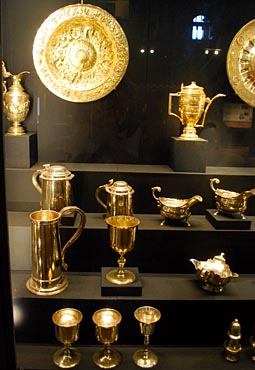The Middle Ages cannot reasonably be seen as a period of revolutionary economic change.
Yet, though it hardly needs saying, the England over which the Tudors acquired rule
was quite different from that of Domesday Book in many ways. A much greater proportion
of the population was resident in towns and reliant on inland trade both for subsistence
and for the comforts of life. There was similarly a higher reliance on money both to fuel
and grease the economic apparatus. The infrastructure of inland commerce was
far more developed, better organized, and more reliable. This infrastructure included
a larger and more evenly dispersed number of towns, licensed markets, fairs, and
ports – some thousands of them – not to mention an incalculable number
of small illicit markets, stall-clusters housed in public halls or private booths,
street-level or cellar shops and taverns based in the owners' homes or in rented rooms
within large houses owned by others, and at the lowest level of retail
the itinerant street vendors. The reinvented urbanity was the gradual outcome
of a number of factors, such as changing socio-economic habits, greater materialism
and a decline in self-sufficiency, adaptation of traditional estate management strategy
by opportunistic members of the aristocracy, and the efforts of national government
to stimulate and standardize trading.
The conduct of overseas trade had benefited from improvements (some foreign in origin)
in transactional techniques, notably those in the extension of credit and
a risk-reduction approach to organizing mercantile ventures, as well as in
a legal system better able to cope with the particular needs and challenges
of international commerce. In regard to labour, skill-sets – some new,
but most developed out of long-standing traditions – had become better diffused
through a more systematic and less family-dependent approach to training
and knowledge transfer. These skills included, not least, the spread of
lay literacy which encouraged the use of written contracts and the keeping
of financial accounts – the latter still mainly a tool of institutions
(although poor survival chances may obscure the degree of accounting by private businessmen).
Innovations, though they might seem small compared to some of the changes arising
out of the so-called Industrial Revolution, helped increase productivity.
The values, norms, and behaviours underlying commercial activity (which included
the notion of reinvesting a percentage of profits in ways that benefited
the community at large) were more widely agreed-upon by participants, more
widely accepted by onlookers who had once been disapproving but had become beneficiaries
of commercialization, and enforced more consistently throughout the realm by central
and local authorities who had come to appreciate how they could cash in on the trend.
While from one perspective the more elaborate regulatory system restricted
the freedom of trade and imposed added costs on it, from another it provided
traders and consumers with protections against bad faith dealing (allowing for
more trust in transactions), made clearer the manner in which legitimate commerce
could be carried out, while implicitly placing constraints on arbitrary interference
with such activities by the authorities.
In all these areas it was a matter both of doing better things and doing things better,
within a developing framework of national administration in which the towns played
an integral role. That role derived in part from the monarchy's growing appreciation
of the ways in which civic leaders could act as the local arm of enforcement of royal
policies; but also from the growing recognition by leading townsmen – particularly
those whose economic interests made them reliant on a world outside their home towns –
that they needed a voice (notably through Parliament) in the formulation, or re-formulation,
of national policy and in the shaping of international relationships. These perceptions of
the two levels of government, complementary on the surface at least, shared the belief
that relatively free-flowing commerce (within a context of customary privileges advantaging
natives), secure markets, safety of travel, controlled development of industry,
and maintenance of social harmony and peaceful foreign relations were
foundation stones of economic prosperity, both in terms of increasing profit and
decreasing transaction costs.
We should not think that the commercial network produced by all these changes
was homogeneous, however, but rather perceive it hierarchically. As is the case today,
there were greater and lesser players, and the situation was constantly in
a state of flux. The designation of 'merchant' could be applied to modest retailers,
to small-scale importer/exporters, and to men of considerable wealth and
wide-ranging business assets and activities; generally, it served only
to differentiate those who were primarily engaged in manufacturing goods from
those who traded goods; insofar as merchants added any value to the goods,
it was in aggregating quantities and/or transporting them to where they were needed
(whether by consumers or by other middlemen). The category of 'towns' also covers
a spectrum of economic roles:
- distribution centres – some little more than
large villages, and others artificial plantations hoping to become competitive in
the developing economic network – serving little more than the surrounding region and
for some of which farming remained a major source both of occupation and commerce;
- places where some industrial specialization or high availability of
a particular raw material (e.g. herring at Yarmouth, iron and ironware at Gloucester,
caps at Coventry, russet cloth at Colchester)
made them of interest to a wider clientele and gained for their producers, and sometimes
for local traders, (though often only for a time) some niche in the economy;
- established cities and well-situated ports offering a wide range of commodities
and services to a diversified customer base and attracting middlemen from across
the country and abroad;
- and finally that exceptional metropolis, London, the principal funnel for
luxury goods from the continent and farther afield.
Yet all of these types of towns had important parts to play in the commercial network,
though their roles differed from each other; and all had indispensable connections,
whether direct or intermediated, with rural producers of the raw materials
which underlay most economic activity.
In their efforts to protect, manage, and develop the local economy, borough leaders
had to keep in mind that their town was an integral part of a larger system
that included rural producers and marketplaces, other towns and their traders,
foreign merchants and marketplaces, and the royal administration of the realm.
While it was sometimes necessary to take a combattive stance against what was
seen (or portrayed) as unfair outside competition, policies of collaboration
were probably recognized as more conducive to fostering commerce. Attracting
outsiders, whether English or foreigners, to a town to do business there required
respecting their rights, such as toll exemptions, and catering to their needs,
such as for local accommodations in a supportive environment and provision of
speedy justice should they have cause for complaint. It also required acquiring
and maintaining a favourable reputation among outsiders, as well as potential settlers,
as a safe, well-ordered, and profitable place to conduct business. Part of the latter
involved effective control of standards among local traders – behaviours,
weights and measures, prices, quality of goods. Effective administration of
these matters – or at least the appearance of such – was also important
for remaining in the good graces of the king, or other influential persons, whose
favourable opinion of a town was worth maintaining for a number of reasons, not least
in case their support might be needed in some matter of grievance between the town
and an outside agency. At the same time, policing of standards was expected of
civic authorities by the citizenship, whose interests – in terms both of
equitable opportunities and communal reputation – was put at risk by dishonest
traders. Yet, given that certain breaches of the letter of the law were necessary
to earning a living, administrators had to interpret their regulatory duties
flexibly so as not to create, punitively, disincentives to profit-taking behaviours
that were, within limits, acceptable in the commercial-cultural norms of urban society.
They also had to work with and through gild organizations that existed to assure
a degree of competitive advantage for their particular constituencies.
Keeping all these various interest groups reasonably satisfied was a delicate balancing
act for civic authorities – whose membership, we must always remember, was dominated
by men whose own socio-economic status derived from profitable commerce – but
one necessary to enable commercial activity to flow in a relatively free and natural
manner, while generating the spin-off revenues for which the lords of the land had,
in the first place, authorized commercial institutions and powers to govern them
(some of which revenues came to be applied to maintaining or improving the infrastructure
supporting local commerce), and yet guarding against greed-driven excesses that were
defined as crime and/or sin. Much the same balancing act was characteristic of
towns in other parts of medieval Europe, as well as cities of the ancient and modern
worlds, for it was an inherent part of the commercial character of urban places.
AMOR, Nicholas. Late Medieval Ipswich: Trade and Industry, Woodbridge:
Boydell Press, 2011.
ASHLEY, W.J. An Introduction to English Economic History and Theory, Part I:
The Middle Ages, 4th ed. London: Longmans, Green and Co., 1909.
Boydell Press, 2011.
BLONDÉ, Bruno et al. eds. Buyers and sellers: Retail circuits and practices
in medieval and early modern Europe, Turnhout: Brepols, 2006.
BRITNELL, Richard. The Commercialisation of English Society 1000-1500, 2nd ed.
Manchester University Press, 1996.
CARUS-WILSON, Eleanora. "The Medieval Trade of the Ports of the Wash,"
Medieval Archaeology, vol.6-7 (1962-3), pp.182-201.
CASSON, Catherine. "Reputation and responsibility in medieval English towns:
civic concerns with the regulation of trade," Urban History, vol.39 (2012)
pp.387-408.
CLARK, David. "The Shop within?: An Analysis of the Architectural Evidence for
Medieval Shops," Architectural History, vol.43 (2000), 58-87.
DAVIS, James. Medieval Market Morality: Life, Law and Ethics in the English Marketplace,
1200-1500, Cambridge: University Press, 2012.
DYER, Christopher. An Age of Transition? Economy and Society in England
in the Later Middle Ages, Oxford: Clarendon Press, 2005.
ELTON Charles and B. COSTELLOE. First report of the Royal Commission on
Market Rights and Tolls, London: H.M.S.O., 1889.
HICKS, Michael, ed. English Inland Trade 1430-1540: Southampton and its Region,
Oxford: Oxbow Books, 2015.
JAMES, Margery Kirkbride. Studies in the Medieval Wine Trade, Oxford:
Clarendon Press, 1971.
KERMODE, Jenny. Medieval Merchants: York, Beverley and Hull in the Later Middle Ages,
Cambridge: University Press, 1998.
KOWALESKI, Maryanne. Local Markets and Regional Trade in Medieval Exeter, Cambridge:
University Press, 2003.
LETTERS, Samantha. Online Gazetteer of Markets and Fairs in England and Wales to 1516,
London: Centre for Metropolitan History (http://www.history.ac.uk/cmh/gaz/gazweb2.html;
last updated 2013)
LLOYD, T.H. Alien Merchants in England in the High Middle Ages, Brighton:
Harvester Press, 1982.
MASSCHAELE, James. Peasants, Merchants and Markets: Inland trade in medieval England,
1150-1350, New York: St. Martin's Press, 1997
MILNE, Gustav and Brian HOBLEY, eds. Waterfront archaeology in Britain and
Northern Europe, Council for British Archaeology Research Report No. 41 (1981).
MOORE, Ellen Wedemeyer. The Fairs of Medieval England: An Introductory Study,
Toronto: Pontifical Institute of Mediaeval Studies, 1985.
OGILVIE, Sheilagh. Institutions and European Trade: Merchant Guilds, 1000-1800,
Cambridge: University Press, 2011.
PAGE, Mark. "Shops and Shopkeepers in medieval Hampshre: Evidence from Fareham and Havant
before the Black Death," Hampshire Studies, vol.66 (2011), pp.153-65.
POWER, Eileen and M.M. POSTAN, eds. Studies in English Trade in the 15th Century,
London: Routledge, 1933.
SAGUI, Samantha. “Crime and Conviviality: The Social Space of Urban Drinking-Houses in
Medieval England,” Paper presented at the Medieval England Conference,
Fordham University, 2007.
SEABOURNE, Gwen. Royal Regulation of Loans and Sales in Medieval England,
Woodbridge: Boydell Press, 2003.



